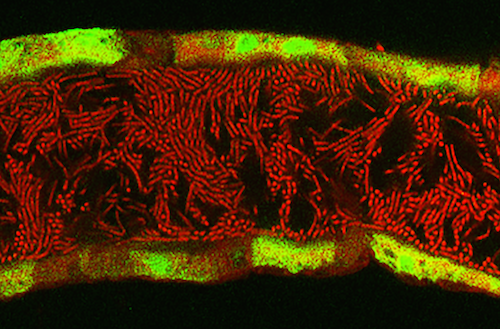Research on a helpful part of the microbiome -- beneficial intestinal bacteria -- is moving from “what is there” to “how they help.”
Scientists at Emory University School of Medicine have shown how an ancient cellular regulatory circuit called Nrf2, present in both insects and mammals, responds to beneficial bacteria and gears up a protective response to environmental stresses. The findings could potentially lead to advances in the use of bacteria to treat intestinal diseases or mitigate the effects of radiation therapy for cancer.
The results were published Thursday, August 13 by Cell Reports.
“The body’s response to bacteria is often seen through the lens of the immune system,” says senior author Andrew Neish, MD, professor of pathology and laboratory medicine at Emory University School of Medicine. “The pathway we’ve identified is not inflammatory or immunoregulatory; rather, it’s cytoprotective.”
While many types of bacteria that live in our intestines are inert or even harmful to intestinal cells, a small subset – lactobacilli – can stimulate increased motility, proliferation and ability to withstand stress, Neish says.
“Lactobacilli are present in yogurt, and they’re also the first kind of bacteria that will colonize a baby’s system after the baby is born,” he says.
Working with Neish, assistant professor of pediatrics Rheinallt Jones, PhD and colleagues found that only lactobacilli could protect previously “germ free” fruit flies from paraquat, a toxic herbicide. Similarly, feeding lactobacilli, but not other types of bacteria, to germ-free mice could protect them from weight loss and death after exposure to radiation.
In intestinal tissues in both flies and mice, the lactobacilli turned on a series of genes in a pattern that indicates that the Nrf2 pathway is involved. If the flies or the mice had a mutation disabling Nrf2, the protective effect from the bacteria was not seen.
Nrf2 is a cellular pathway involved in protecting cells against external stresses such as toxins and carcinogens, and it is activated by reactive oxygen species or ROS. Both paraquat and radiation generate ROS.
“It looks like a little bit of ROS helps cells get ready to withstand stress,” Jones says. “This is an example of the concept of hormesis, where limited exposure to something that is harmful protects an organism from more of it later.”
Previously, Jones and Neish have shown that lactobacilli stimulate intestinal epithelial cells to produce ROS, which are a key signal for wound healing. In the Cell Reports paper, the researchers showed that when the enzyme Nox1, which makes ROS in response to bacteria, is removed from the intestines in mice, the radioprotective effect of lactobacilli is lost.
While it is not the only regulatory circuit stimulated by beneficial bacteria, Jones and Neish say their findings suggest that Nrf2 is more highly conserved than other bacterially-induced signals, and that it likely evolved as a mechanism for higher organisms to co-exist with bacteria.
Jones and Neish say they are investigating the common genetic signatures of the various types of bacteria that stimulate ROS and Nrf2. That could help researchers sort through which ones may have therapeutic benefits, and possibly how to mimic the bacteria with synthetic agents.
To facilitate this type of research, Jones is establishing a gnotobiotic animal facility at Emory, which will enable scientists to investigate what happens when an animal’s intestines are colonized with only one variety of bacteria.
The research was supported by the National Institute of Diabetes and Digestive and Kidney Diseases (R01DK089391, R01DK071604) and the National Institute of Allergy and Infectious Diseases (RO1AI064462).

